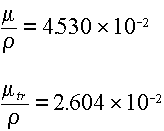Lesson 18 - Photon response functions
When we turn our attention from neutron response functions to photon response
functions, are job gets more complicated because of two facts:
- The notation for photon response functions is traditionally different than for neutrons,
so we have to learn it.
- We cannot be so sure of what particles are being "covered" by the flux
calculation.
Photon notation
First, let's deal with the notational difference. So far, our equation for the
local response functions (by which we mean the response function for material that affects
the flux) has been the one developed in Lesson 16:

where  is the energy transferred to the material medium by secondary charged particles due to
neutron reaction type j of isotope i.
is the energy transferred to the material medium by secondary charged particles due to
neutron reaction type j of isotope i.
We have already seen that photon reaction coefficients are historically
expressed in terms of the linear attenuation coefficient:

Well, since the  are dependent on the i and j summations, it is difficult to
provide a direct analog of the first equation using the are dependent on the i and j summations, it is difficult to
provide a direct analog of the first equation using the  . How the traditional photon notation has treated this
difficulty has been to define a family "linear deposition coefficients" with the
general form of: . How the traditional photon notation has treated this
difficulty has been to define a family "linear deposition coefficients" with the
general form of:

which results in the response function being defined as:

Several important points need to be made about the  : :
Although they look like interaction coefficients and have the same units
(1/cm) as macroscopic cross sections, they cannot be multiplied by flux
to get any physical reaction rate.
Likewise, for the same reason they cannot be used to compute exponential
attenuation rates.
Note: You should get it firmly in mind that if I ask you
for an attenuation rate that involves computing a value  , there will NEVER be a subscript on the , there will NEVER be a subscript on the  . .
Matching of flux with deposition coefficient
If you look at the tables in Appendix C, you will not find a listing for  . We have been using this
symbol as a "stand-in" for linear coefficients that will allow us to approximate
the dose rate -- when multiplied by the energy E of the incident photon
and by the photon flux. . We have been using this
symbol as a "stand-in" for linear coefficients that will allow us to approximate
the dose rate -- when multiplied by the energy E of the incident photon
and by the photon flux.
This last phrase "... and by the photon flux" is where the problem comes in.
The photon reaction mechanisms that we studied earlier -- photoelectric effect, Compton
scattering, and pair production -- result in the release of a range of secondary photons.
Some of them have relatively high energies -- especially the pair production
photons at 0.511 MeV and the Compton photons, which usually have energies comparable to
the incident photon. Others, however, have very low energies -- especially the
photons from Bremsstrahlung and the fluorescent photons from the photoelectric reactions.
The question is: Are each of these categories of photons included in the flux
calculation or not?
You should become familiar with Figure 5.4 in the book, so that you can properly match
up the energy deposition coefficient to use with the details of the flux calculation. In
summary, you should use:
 if Compton scatter photons
are included in the flux calculation, but not the others. if Compton scatter photons
are included in the flux calculation, but not the others. if Compton scatter and
pair-production photons are included in the flux calculation, but not fluorescence or
Bremsstrahlung photons. if Compton scatter and
pair-production photons are included in the flux calculation, but not fluorescence or
Bremsstrahlung photons. if all sources except
Bremsstrahlung photons are included in the flux calculation. (NOTE: This is the
coefficient that most closely corresponds to kerma, since the (intermediate) electrons
would be considered to be secondary charged particles.) if all sources except
Bremsstrahlung photons are included in the flux calculation. (NOTE: This is the
coefficient that most closely corresponds to kerma, since the (intermediate) electrons
would be considered to be secondary charged particles.) if all four sources of
secondary photons are included in the flux calculation. if all four sources of
secondary photons are included in the flux calculation.
Example: For a flux of 100 particles/s/cm2
of 2 MeV photons in lead of density 11.7 g/cc, what is the (a) kerma
rate and (b) the reaction rate in the lead? (Assume that the proper
deposition cross section is the linear energy transport cross section,
 . .
Answer: Using the value for lead given in Table
C.5, the interaction coefficients at 2 MeV are:
 , both in
cm2/g , both in
cm2/g
Using the first of these, the reaction rate (in mass units) is found by
multiplying the mass interaction coefficient by the flux to get:

The associated kerma is found from:

You should closely study the examples in section 5.7.4 of the text.
|  NE406
Radiation Protection and Shielding
NE406
Radiation Protection and Shielding